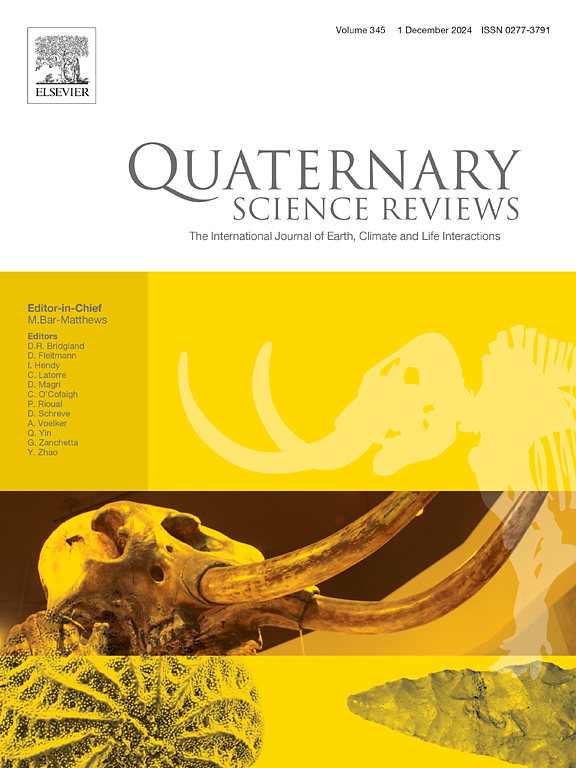中亚东北部伊犁黄土Rb/Sr比值的新解释
IF 3.3
1区 地球科学
Q1 GEOGRAPHY, PHYSICAL
引用次数: 0
摘要
黄土沉积物中的铷/锶(Rb/Sr)比值是中国黄土高原(CLP)土壤形成和东亚夏季风强度的一个公认指标。然而,其在中亚黄土中的意义仍未得到充分探讨。利用随机森林和偏最小二乘回归等机器学习技术,研究了中亚东北部伊犁盆地Rb/Sr比值的影响因素。结果表明,Rb/Sr比值与春夏初夏气温有较强的相关性,特别是在3、5、6月。与CLP不同的是,在CLP中,浸出主要驱动Rb/Sr变化,在伊犁盆地,受3 - 6月温度影响的植被动态是主要影响因素。在此基础上,重建了末次冰期至全新世中期的Rb/Sr叠合记录。这一记录与NCA温度变化非常相似,并与轨道和千年尺度上的冰川动力学有关。Rb/Sr叠置序列表明,NCA春季至初夏温度在海洋同位素阶段(MIS) 4和MIS 3b期间最低,在12.5 ka左右达到峰值,在全新世早期至中期呈下降趋势。此外,从MIS 3a到MIS 2的显著变暖趋势与热带印度洋北部海面温度的变化有关,这影响了Hadley环流。这些发现将Rb/Sr比值定位为NCA黄土古温标,为研究区域古环境动力学提供了新的思路。本文章由计算机程序翻译,如有差异,请以英文原文为准。
New interpretation of the Rb/Sr ratio of the Ili loess, northeastern Central Asia
The rubidium/strontium (Rb/Sr) ratio in loess deposits is a widely recognized indicator of pedogenesis and East Asian Summer Monsoon intensity on the Chinese Loess Plateau (CLP). However, its significance in Central Asian loess remains underexplored. This study utilizes machine learning techniques, including Random Forest and Partial Least Squares Regression to investigate the factors influencing the Rb/Sr ratio in the Ili Basin, northeastern Central Asia (NCA). The results reveal a strong correlation between the Rb/Sr ratio and spring to early summer temperature, particularly in March, May, and June. Unlike in the CLP, where leaching primarily drives Rb/Sr variations, vegetation dynamics, which are influenced by temperatures from March to June, are the dominant influence in the Ili Basin. Based on these findings, a stacked Rb/Sr record was reconstructed, spanning the Last Glacial Period to the mid-Holocene. This record is closely similar to NCA temperature variations and related to glacial dynamics on orbital and millennial scales. The stacked Rb/Sr sequence indicates that spring to early summer temperatures in NCA were lowest during Marine Isotope Stage (MIS) 4 and MIS 3b, then increased to peak around 12.5 ka, and declined from the early to mid-Holocene. Furthermore, a significant warming trend from MIS 3a to MIS 2 is linked to changes in sea surface temperature in the northern tropical Indian Ocean, which influenced the Hadley cell. These findings position the Rb/Sr ratio as a novel paleotemperature proxy for loess in NCA, offering new insights into regional paleoenvironmental dynamics.
求助全文
通过发布文献求助,成功后即可免费获取论文全文。
去求助
来源期刊

Quaternary Science Reviews
地学-地球科学综合
CiteScore
7.50
自引率
15.00%
发文量
388
审稿时长
3 months
期刊介绍:
Quaternary Science Reviews caters for all aspects of Quaternary science, and includes, for example, geology, geomorphology, geography, archaeology, soil science, palaeobotany, palaeontology, palaeoclimatology and the full range of applicable dating methods. The dividing line between what constitutes the review paper and one which contains new original data is not easy to establish, so QSR also publishes papers with new data especially if these perform a review function. All the Quaternary sciences are changing rapidly and subject to re-evaluation as the pace of discovery quickens; thus the diverse but comprehensive role of Quaternary Science Reviews keeps readers abreast of the wider issues relating to new developments in the field.
 求助内容:
求助内容: 应助结果提醒方式:
应助结果提醒方式:


